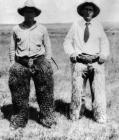28
Bronc riders were identified by their garb - ten gallon hats, silk neckerchiefs, white shirts, angora chaps, high heeled boots and jangling spurs. . ."In the 1920's the cowboys started wearing those angora chaps - white ones and black, and green or even orange, or some wore batwings and a few wore the ones with shotgun legs. Just about everyone wore a vest and maybe a shirt with those big buttons or a silk shirt and hats with a peak, a Carlsbad hat and inlaid boots"
-Gene Anderson
30
There were always rules about a cowboy's gear. When a contestant left the chute he had to be wearing a hat. Spurs were for more than show. The bronc riders kicked the horses with the spurs to encourage them to buck. At first there were no rules about the rowels and they were fairly sharp. Gradually rules about spurs and spurring were adopted.32
The contestants' names were announced from the judging stands with the use of a megaphone to amplify the speaker's voice. Other arena managers also directed events from the ground with megaphones."The announcers rode around the arena with a megaphone and said things like 'Keep the track clear, there's a race coming up. This will be the rancher's race' "
-Gene Anderson
34
A Stampede was a combination of events. At Wood Mountain there was a parade put on by the Lakota Sioux Indians dressed in traditional clothing."At Wood Mountain Stampede time in early July I went up to the Post with the Layton family. The Indians in their beaded buckskin and feathered war bonnets made a good parade that day and then retired to the hill west of the parade ground to watch the Rodeo."
- Edna Riley Shapley
36
The Lakota Sioux, who lived on a reserve west of the Stampede site, tented on a hillside on the Stampede grounds. Each year the Stampede committee brought a beef for them and they butchered it in the camp and shared it amongst the families.38
Chief Joe Ferguson carried the Union Jack and led the parade for more than thirty years. Behind "Big Joe" as he was known, followed several more riders and often one or two women with travois and children. Everyone wore traditional garments, beaded clothing and moccasins. Most of the men wore head dresses of eagle feathers.40
Elizabeth Ogle often won the prize awarded to the best dressed Lakota lady." My mother used to tan that leather, deerskin, buckskin they called it, and then she made dresses and jackets out of it and trimmed everything with beads. Later on I used to make my own costumes and some for my grandchildren, too. You know, we didn't wear those clothes all the time, just at the Sports."
- Elizabeth Ogle






